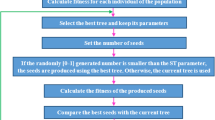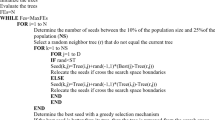Abstract
The tree-seed algorithm, TSA for short, is a new population-based intelligent optimization algorithm developed for solving continuous optimization problems by inspiring the relationship between trees and their seeds. The locations of trees and seeds correspond to the possible solutions of the optimization problem on the search space. By using this model, the continuous optimization problems with lower dimensions are solved effectively, but its performance dramatically decreases on solving higher dimensional optimization problems. In order to address this issue in the basic TSA, an integration of different solution update rules are proposed in this study for solving high dimensional continuous optimization problems. Based on the search tendency parameter, which is a peculiar control parameter of TSA, five update rules and a withering process are utilized for obtaining seeds for the trees. The performance of the proposed method is investigated on basic 30-dimensional twelve numerical benchmark functions and CEC (congress on evolutionary computation) 2015 test suite. The performance of the proposed approach is also compared with the artificial bee colony algorithm, particle swarm optimization algorithm, genetic algorithm, pure random search algorithm and differential evolution variants. Experimental comparisons show that the proposed method is better than the basic method in terms of solution quality, robustness and convergence characteristics.




Similar content being viewed by others
Explore related subjects
Discover the latest articles and news from researchers in related subjects, suggested using machine learning.References
Araújo RDA, Vasconcelos GC, Ferreira TA. Improved differential evolution for single objective optimization problems. https://www.cos.ufrj.br/~ines/enia07_html/pdf/28044.pdf. Accessed 2019
Asafuddoula M, Ray T, Sarker R (2014) An adaptive hybrid differential evolution algorithm for single objective optimization. Appl Math Comput 231:601–618
Aslan M, Beskirli M, Kodaz H, Kıran MS (2018) An improved tree seed algorithm for optimization problems. Int J Mach Learn Comput 8(1):20–25
Babalik A, Cinar AC, Kiran MS (2018) A modification of tree-seed algorithm using Deb’s rules for constrained optimization. Appl Soft Comput 63:289–305
Brooks SH (1958) A discussion of random methods for seeking maxima. Oper Res 6(2):244–251
Chau K-W (2007) Reliability and performance-based design by artificial neural network. Adv Eng Softw 38(3):145–149
Chen WJ, Tan XJ, Cai M (2017) Parameter identification of equivalent circuit models for Li-ion batteries based on tree seeds algorithm. In: IOP conference series: earth and environmental science, vol 73, no 1. IOP Publishing, p 012024
Çınaroğlu S, Bulut H (2018) K-Ortalamalar ve parçacık sürü optimizasyonu tabanlı kümeleme algoritmaları için yeni ilklendirme yaklaşımları. Gazi Üniversitesi Mühendislik-Mimarlık Fakültesi Dergisi 33(2):413–424
Cinar AC, Kiran MS (2016) A parallel version of tree-seed algorithm (TSA) within CUDA platform. In: Selçuk international scientific conference on applied sciences, 27–30 Sept, Antalya, Turkey, pp 174–178
Cinar AC, Kiran MS (2017) Boundary conditions in tree-seed algorithm: analysis of the success of search space limitation techniques in tree-seed algorithm. In: 2017 international conference on computer science and engineering (UBMK). IEEE, pp 571–576
Cinar AC, Kiran MS (2018) Similarity and logic gate-based tree-seed algorithms for binary optimization. Comput Ind Eng 115:631–646
Das S, Mullick SS, Suganthan PN (2016) Recent advances in differential evolution–an updated survey. Swarm Evolut Comput 27:1–30
Davis L (ed) (1991) Handbook of genetic algorithms. Van Nostrand Reinhold, New York
Eberhart R, Kennedy J (1995) A new optimizer using particle swarm theory. In: MHS'95. Proceedings of the sixth international symposium on micro machine and human science. IEEE, pp 39–43
Ekinci S, Hekimoğlu B (2017) HPA algoritması ile çok makinalı güç sistemi kararlı kılıcısı tasarımı. Gazi Üniversitesi Mühendislik-Mimarlık Fakültesi Dergisi 32(4):1271–1285
El-Fergany AA, Hasanien HM (2018) Tree-seed algorithm for solving optimal power flow problem in large-scale power systems incorporating validations and comparisons. Appl Soft Comput 64:307–316
Holland JH (1975) Adaptation in natural and artificial systems. University of Michigan Press, Ann Arbor, MI
Janikow CZ, Michalewicz Z (1991) An experimental comparison of binary and floating point representations in genetic algorithms. In: Proceedings of the 4th international conference on genetic algorithms, San Diego, CA, USA
Karaboga D (2005) An idea based on honey bee swarm for numerical optimization. Technical report-TR06, Erciyes University, Engineering Faculty, Computer Engineering Department
Karaboga D, Basturk B (2007) A powerful and efficient algorithm for numerical function optimization: artificial bee colony (ABC) algorithm. J Glob Optim 39(3):459–471
Kazemi S, Minaei Bidgoli B, Shamshirband S, Karimi SM, Ghorbani MA, Chau K-W, Kazem Pour R (2018) Novel genetic-based negative correlation learning for estimating soil temperature. Eng Appl Comput Fluid Mech 12(1):506–516
Kiran MS (2015) TSA: tree-seed algorithm for continuous optimization. Expert Syst Appl 42(19):6686–6698
Kıran MS (2016) An implementation of tree-seed algorithm (TSA) for Constrained optimization. In: Lavangnananda K, Phon-Amnuaisuk S, Engchuan W, Chan JH (eds) Intelligent and evolutionary systems: The 19th Asia Pacific symposium, IES 2015, Bangkok, Thailand, November 2015, proceedings. Springer International Publishing, Cham, pp 189–197
Kiran MS (2017) Particle swarm optimization with a new update mechanism. Appl Soft Comput 60:670–678
Kiran MS (2017) Withering process for tree-seed algorithm. Proc Comput Sci 111:46–51
Kiran MS, Gunduz M (2013) A recombination-based hybridization of particle swarm optimization and artificial bee colony algorithm for continuous optimization problems. Appl Soft Comput 13(4):2188–2203
Kıran MS, Gündüz M, Baykan ÖK (2012) A novel hybrid algorithm based on particle swarm and ant colony optimization for finding the global minimum. Appl Math Comput 219(4):1515–1521
Kıran MS, Özceylan E, Gündüz M, Paksoy T (2012) A novel hybrid approach based on particle swarm optimization and ant colony algorithm to forecast energy demand of Turkey. Energy Convers Manag 53(1):75–83
Liang J, Qu B, Suganthan P, Chen Q (2014) Problem definitions and evaluation criteria for the CEC 2015 competition on learning-based real-parameter single objective optimization. Technical Report201411A, Computational Intelligence Laboratory, Zhengzhou University, Zhengzhou China and Technical Report, Nanyang Technological University, Singapore
Luenberger D, Ye Y (2008) Linear and nonlinear programming. Springer, New York, NY
Mahdavi S, Shiri ME, Rahnamayan S (2015) Metaheuristics in large-scale global continues optimization: a survey. Inf Sci 295:407–428
Mahi M, Baykan OK, Kodaz H (2018) A new approach based on particle swarm optimization algorithm for solving data allocation problem. Appl Soft Comput 62:571–578
Moazenzadeh R, Mohammadi B, Shamshirband S, Chau K-W (2018) Coupling a firefly algorithm with support vector regression to predict evaporation in northern Iran. Eng Appl Comput Fluid Mech 12(1):584–597
Muneeswaran V, Rajasekaran MP (2016) Performance evaluation of radial basis function networks based on tree seed algorithm. In: 2016 international conference on circuit, power and computing technologies (ICCPCT). IEEE, pp 1–4
Qin AK, Li X (2013) Differential evolution on the CEC-2013 single-objective continuous optimization testbed. In: 2013 IEEE congress on evolutionary computation. IEEE, pp 1099–1106
Qin AK, Suganthan PN (2005) Self-adaptive differential evolution algorithm for numerical optimization. In: 2005 IEEE congress on evolutionary computation, vol 2. IEEE, pp 1785–1791
Qin AK, Huang VL, Suganthan PN (2009) Differential evolution algorithm with strategy adaptation for global numerical optimization. IEEE Trans Evolut Comput 13(2):398–417
Rai MM (2006) Single- and multiple-objective optimization with differential evolution and neural networks. In: VKI lecture series: introduction to optimization and multidisciplinary design, 6–10 March, pp 1–32
Robinson J, Rahmat-Samii Y (2004) Particle swarm optimization in electromagnetics. IEEE Trans Antennas Propag 52(2):397–407
Şahman MA, Altun AA, Dündar AO (2018) A new MILP model proposal in feed formulation and using a hybrid-linear binary PSO (H-LBP) approach for alternative solutions. Neural Comput Appl 29(2):537–552
Shi Y (2001) Particle swarm optimization: developments, applications and resources. In: Proceedings of the 2001 congress on evolutionary computation (IEEE Cat. No. 01TH8546), vol 1. IEEE, pp 81–86
Storn R, Price K (1997) Differential evolution—a simple and efficient heuristic for global optimization over continuous spaces. J Glob Optim 11(4):341–359
Taormina R, Chau K-W, Sivakumar B (2015) Neural network river forecasting through baseflow separation and binary-coded swarm optimization. J Hydrol 529:1788–1797
Wu C, Chau K (2011) Rainfall–runoff modeling using artificial neural network coupled with singular spectrum analysis. J Hydrol 399(3–4):394–409
Zabinsky ZB (2009) Wiley encyclopedia of operations research and management science. In: Random search algorithms. Wiley, New York
Zhang S, Chau KW (2009) Dimension reduction using semi-supervised locally linear embedding for plant leaf classification. In: International conference on intelligent computing. Springer, Berlin, pp 948–955
Zielinski K, Laur R (2006) Constrained single-objective optimization using differential evolution. In: 2006 IEEE international conference on evolutionary computation. IEEE, pp 223–230
Author information
Authors and Affiliations
Corresponding author
Additional information
Publisher's Note
Springer Nature remains neutral with regard to jurisdictional claims in published maps and institutional affiliations.
Rights and permissions
About this article
Cite this article
Gungor, I., Emiroglu, B.G., Cinar, A.C. et al. Integration search strategies in tree seed algorithm for high dimensional function optimization. Int. J. Mach. Learn. & Cyber. 11, 249–267 (2020). https://doi.org/10.1007/s13042-019-00970-1
Received:
Accepted:
Published:
Issue Date:
DOI: https://doi.org/10.1007/s13042-019-00970-1




